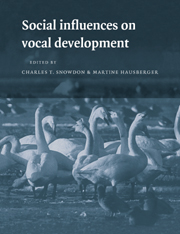Book contents
- Frontmatter
- Contents
- List of contributor
- 1 Introduction
- 2 Social interaction and sensitive phases for song learning: A critical review
- 3 Social interaction and vocal development in birds
- 4 Building a social agenda for the study of bird song
- 5 Field observations, experimental design, and the time and place of learning bird songs
- 6 Vocal learning in wild and domesticated zebra finches: Signature cues for kin recognition or epiphenomena?
- 7 What birds with complex social relationships can tell us about vocal learning: Vocal sharing in avian groups
- 8 Social influences on song acquisition and sharing in the European starling (Sturnus vulgaris)
- 9 Social influences on the acquisition of human-based codes in parrots and nonhuman primates
- 10 Vocal learning in captive bottlenose dolphins: A comparison with humans and nonhuman animals
- 11 Vocal learning in cetaceans
- 12 Social influences on vocal development in New World primates
- 13 Some general features of vocal development in nonhuman primates
- 14 Social influences on vocal learning in human and nonhuman primates
- 15 The resilience of language in humans
- 16 Reciprocal interactions and the development of communication and language between parents and children
- 17 Crafting activities: Building social organization through language in girls' and boys' groups
- Index
10 - Vocal learning in captive bottlenose dolphins: A comparison with humans and nonhuman animals
Published online by Cambridge University Press: 04 August 2010
- Frontmatter
- Contents
- List of contributor
- 1 Introduction
- 2 Social interaction and sensitive phases for song learning: A critical review
- 3 Social interaction and vocal development in birds
- 4 Building a social agenda for the study of bird song
- 5 Field observations, experimental design, and the time and place of learning bird songs
- 6 Vocal learning in wild and domesticated zebra finches: Signature cues for kin recognition or epiphenomena?
- 7 What birds with complex social relationships can tell us about vocal learning: Vocal sharing in avian groups
- 8 Social influences on song acquisition and sharing in the European starling (Sturnus vulgaris)
- 9 Social influences on the acquisition of human-based codes in parrots and nonhuman primates
- 10 Vocal learning in captive bottlenose dolphins: A comparison with humans and nonhuman animals
- 11 Vocal learning in cetaceans
- 12 Social influences on vocal development in New World primates
- 13 Some general features of vocal development in nonhuman primates
- 14 Social influences on vocal learning in human and nonhuman primates
- 15 The resilience of language in humans
- 16 Reciprocal interactions and the development of communication and language between parents and children
- 17 Crafting activities: Building social organization through language in girls' and boys' groups
- Index
Summary
INTRODUCTION
Vocal learning involves the ability to modify and acquire new signals in an organism's vocal repertoire through the use of auditory information and feedback. Humans and many avian species, particularly songbirds, have demonstrated similarities and analogous patterns in the vocal acquisition of their respective repertoires. These similarities include the importance of auditory input, feedback, and social influences on vocal structure and acquisition, and stages of developmental overproduction, selective attrition, and vocal babbling/subsong (for reviews, see Kroodsma 1982; Pepperberg & Neapolitan 1988; Locke 1990, 1993a,b). Finding such parallels in phylogenetically distinct species is striking and suggests a convergence in strategies of vocal learning.
Evidence for vocal learning in other species is rare. Studies of vocal learning in nonhuman primates have suggested that learning plays a role in vocal development of contextual use and comprehension (Seyfarth et al. 1980; Cheney & Seyfarth 1982; Seyfarth 1986; Hauser 1988; Gouzoules & Gouzoules 1989) but clear evidence for the learning of vocal repertoires by nonhuman primates has been slow to emerge. However, recent results of studies of nonhuman primates (Elowson & Snowdon 1994; Snowdon et al., Chapter 12; Mitani & Brandt 1994) and birds (Brown & Farabaugh, Chapter 7) suggest greater vocal plasticity than was previously described and point to an importance of social factors on vocal structure and acoustic variability of calls. Therefore, to more clearly elucidate the phenomenon of vocal learning it is important to make a distinction between vocal learning (the ability to acquire new elements in one's vocal repertoire) and vocal plasticity (the ability to modify signal structure due to social or environmental conditions).
- Type
- Chapter
- Information
- Social Influences on Vocal Development , pp. 178 - 207Publisher: Cambridge University PressPrint publication year: 1997
- 20
- Cited by

